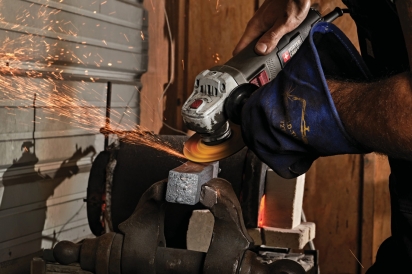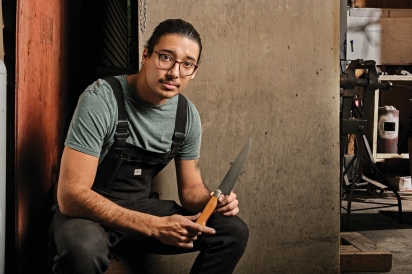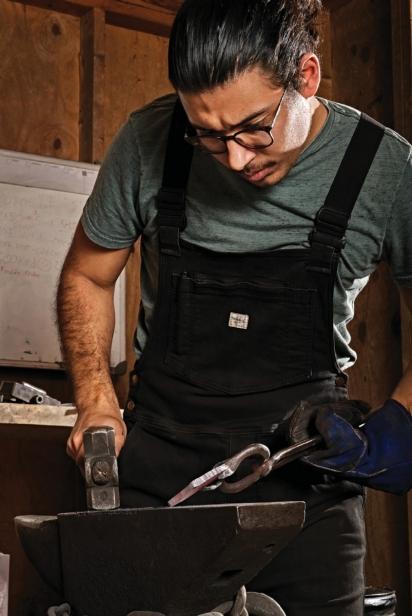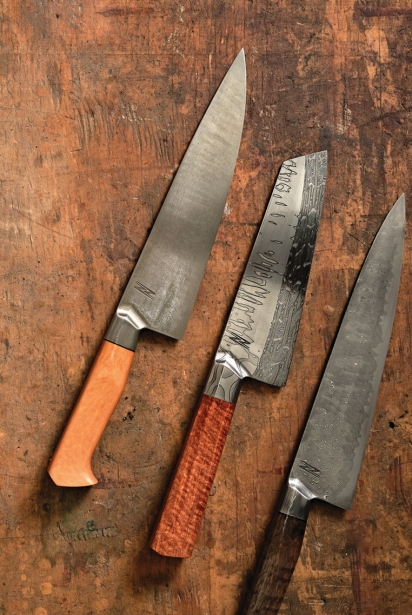Cutting Edge
Knife maker Niko Nicolaides shares what to look for when selecting, and wielding, this key kitchen tool.
WHEN IT COMES to selecting which knives to use in the kitchen, there are many choices, including shape, size and materials. Choosing which knife to use is just as important as selecting ingredients for your recipe—you’ll want to select the right one to get the job done to create the best dish.
“I think any kitchen knife that you’re comfortable using is great—what’s important is a sharp, functional knife,” says Niko Nicolaides, who crafts culinary knives that “are meant to be put to work” through his Detroit-based business Nicolaides Knives.
With handmade knives you are paying for a lot more than just performance, but handmade knives are designed to cut first and foremost.
“Materials and steel choices in knife making are vast and vary based on what kind of knife you are making,” says Nicolaides, whose journey making knives started when he was 19, as a hobby between going to college and working in restaurants. He was studying advanced manufacturing processes with plans to move into studying manufacturing engineering when he stumbled on knife-making videos on YouTube, carving out a new career.
“A steel knife is one of the most important tools in the kitchen,” he says. “Common choices for kitchen knives are both high-carbon steel and stainless steel, each having its own set of properties making it suitable for different purposes.”
Nicolaides says carbon steel is a less common choice for knife making but it is still a popular option due to its durability and ability to hold a sharp edge. It is very hard and known for its strength and edge retention, but there is one downside: It is more prone to rust than stainless steel and requires careful care to prevent corrosion.
Nicolaides says carbon steel knives are favorites among professional chefs and are easier to forge than stainless steel knives.
Stainless steel is a more common choice for knife-making because it is resistant to corrosion, which can make it a good choice for knives that will be used in wet or humid environments. However, it is not as hard as carbon steel, so it may not be as durable.
Nicolaides says carbon steel, more specifically high-carbon steel, is the ideal material for kitchen knives. The high amount of carbon present in the steel provides the corrosion resistance, toughness, tensile strength and edge-holding necessary in a great knife for extended periods.
Learn more
To see more of Nicolaides work visit nicolaidesknives.com
Want to learn about caring for your knives at home? Go to page 44 for Niko’s guide to knife maintenance.
Carbon steel is the oldest type of steel used in knife-making, and it is made up of iron and carbon, and the higher the carbon content, the harder and sharper the steel will be.
The choice of steel can significantly impact the overall performance and longevity of the knife because the harder the material, the longer the sharp edge will last. A sharp knife is essential for making clean and precise cuts, and a dull knife will tear and crush food, which can ruin the flavor and texture.
Another key element of a knife is the handle. Knives should feel comfortable in your hand, making them easy to control. This is important for avoiding accidents. Nicolaides says wood—natural hardwood and stabilized—and composite materials are common for handles.
Mike Lerchenfeldt is a Metro Detroit–based freelance writer and English / language arts teacher. Find him at muckrack.com/ml.









